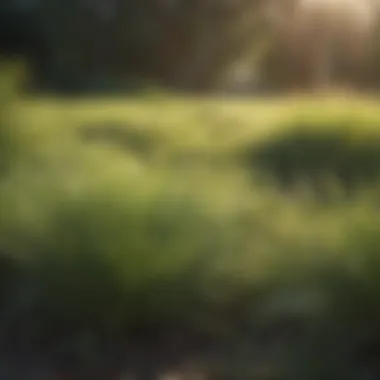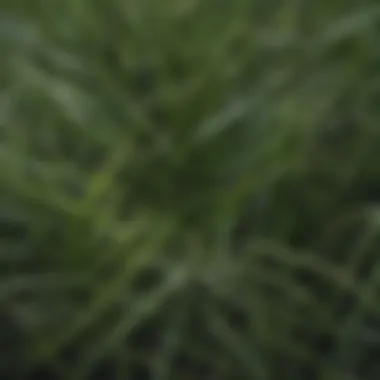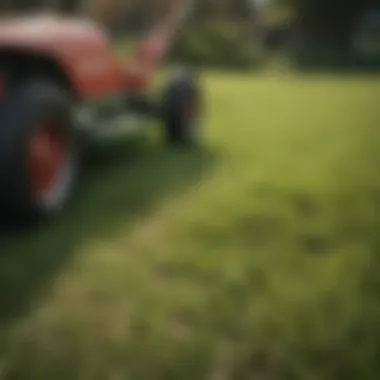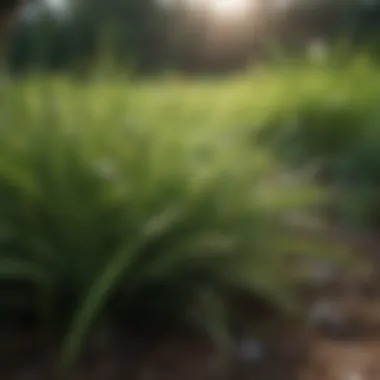An In-Depth Comparison: Bermuda vs. St. Augustine Grass Varieties


Animal Species Profile
Bermuda and St. Augustine grass are two popular grass varieties known for their distinct characteristics and suitability in different climates. Let us delve deeper into the nuances that set these grasses apart, from their growth patterns to maintenance requirements and adaptability. Our exploration will shed light on essential factors crucial for making an informed decision when choosing the ideal grass type for your lawn.
Growth Patterns and Characteristics
Bermuda grass, scientifically known as Cynodon dactylon, is a warm-season grass renowned for its dense, fine texture and rich green color. It thrives in full sun and exhibits excellent drought tolerance, making it a preferred choice for lawns in hot climates. In comparison, St. Augustine grass, also called Stenotaphrum secundatum, boasts a wider blade and a lush, dark green hue. This grass variety is well-suited for shaded areas and exhibits better tolerance to partial shade than Bermuda grass.
When it comes to growth patterns, Bermuda grass spreads aggressively through both above-ground stolons and below-ground rhizomes, rapidly forming a thick turf. On the other hand, St. Augustine grass grows more upright and forms a dense carpet-like appearance, spreading through above-ground stolons. Understanding these growth habits is essential for lawn maintenance and determining the ideal grass for specific lawn needs.
Maintenance Requirements and Adaptability
In terms of maintenance, Bermuda grass requires relatively frequent mowing due to its vigorous growth rate and tendency to become thatchy if not properly managed. It also thrives in well-draining soil and benefits from regular fertilization to maintain its lush appearance. On the contrary, St. Augustine grass has a moderate growth rate, necessitating less frequent mowing compared to Bermuda grass. It prefers fertile soil with good moisture retention and may require occasional dethatching to promote healthy growth.
When considering adaptability to different climates, Bermuda grass excels in hot and arid environments, displaying exceptional heat tolerance and drought resistance. It can withstand high foot traffic and recovers quickly from damage. In contrast, St. Augustine grass is better suited for coastal regions with mild winters, as it is sensitive to frost and cold temperatures. It thrives in areas with consistent moisture and moderate temperatures, making it a preferred choice for lawns in specific geographical locations.
By highlighting these key differences between Bermuda and St. Augustine grass, we provide valuable insights into selecting the most suitable grass variety based on individual preferences, climate conditions, and maintenance capabilities. The detailed comparison presented in this article aims to empower readers with the knowledge needed to make informed decisions and ensure a vibrant and healthy lawn environment.
Prolusion
In this detailed article, we embark on a journey exploring the contrasting features of Bermuda and St. Augustine grass varieties. A meticulous analysis unveils the unique characteristics, growth tendencies, maintenance requisites, and adaptability to diverse climates of these two grass types. By scrutinizing the nuances between Bermuda and St. Augustine grass, readers will gain invaluable insights into choosing the most suitable grass variety for their specific needs.
Whether you're a homeowner, a landscaper, or a curious observer of botanical intricacies, understanding the disparities between Bermuda and St. Augustine grass can significantly impact your lawn care decisions. From aesthetic considerations to practical maintenance requirements, this exploration aims to provide a comprehensive resource for anyone seeking a deeper comprehension of these ubiquitous grass varieties.
Delving beyond the surface disparities, we delve into the intricate details that define each grass type's essence. This in-depth comparison is not merely a superficial examination but a nuanced dissection of the nuances that make Bermuda and St. Augustine grass distinct from each other. With a keen focus on relevant aspects and practical implications, this article serves as a beacon for those navigating the verdant realm of grass species selection.
Characteristics of Bermuda Grass
Appearance
Bermuda grass, renowned for its vibrant hue, exhibits a spectrum of colors ranging from lush green to golden undertones, adding a dynamic element to any landscape. The blade texture varies from fine to medium, contributing to its visual appeal and touch. Its growth habit, characterized by dense coverage and a proclivity for spreading, signifies its resilience and vigor. These visual and textural attributes distinguish Bermuda grass as a popular choice for lawns desiring a manicured look with robust growth potential.
Growing Conditions
In terms of sunlight requirements, Bermuda grass thrives in full sun exposure, displaying optimal growth and vitality under bright light conditions. Its soil preference leans towards well-drained loamy soils with good aeration, enabling root development and overall health. Drought tolerance is a notable trait of Bermuda grass, showcasing its ability to withstand prolonged dry spells with minimal water supplementation. Understanding these growth conditions is crucial for nurturing Bermuda grass to its full potential.
Maintenance
Maintaining Bermuda grass entails strategic mowing practices to achieve an ideal height that balances aesthetics with plant health. Fertilization needs should align with seasonal demands, providing essential nutrients for sustained growth and vitality. Effective pest control measures are imperative to safeguard Bermuda grass from detrimental infestations that can compromise its lush appearance and overall well-being.


Characteristics of St. Augustine Grass
Appearance
St. Augustine grass exhibits a diverse array of color variations, from deep green to bluish-green tones, offering a visually striking presence in any landscape. Its leaf width is noticeably wider compared to Bermuda grass, imparting a dense and luxurious aspect to its overall appearance. The high density of St. Augustine grass further enhances its plush look, creating a velvety carpet effect that appeals to aficionados of lush, thick lawns.
Growing Conditions
Shade tolerance is a key advantage of St. Augustine grass, thriving in areas with partial shade or filtered sunlight where other grass species may struggle. Adequate water requirements are essential for sustaining the lush growth of St. Augustine grass, necessitating regular irrigation to maintain its verdant appeal. Winter hardiness is another notable trait, enabling St. Augustine grass to withstand colder temperatures and inclement weather conditions.
Maintenance
Mowing frequency plays a critical role in preserving the optimal height and density of St. Augustine grass, requiring a consistent schedule to avoid scalping or overgrowth. Fertilization must follow a structured schedule tailored to the specific nutrient needs of St. Augustine grass, ensuring steady growth and vibrant coloration. Effective weed management practices are crucial to prevent invasive species from encroaching on the lush carpet of St. Augustine grass, preserving its pristine appearance.
Adaptability to Different Climates
Tropical Regions
In tropical regions, Bermuda grass demonstrates robust growth behavior, thriving in warm climates with ample sunlight and moderate moisture levels. St. Augustine grass exhibits a contrasting behavior, excelling in tropical settings with higher humidity levels and periodic rainfall, showcasing its adaptability to lush, tropical landscapes.
Temperate Climates
In temperate climates, the survivability of Bermuda and St. Augustine grass varies based on factors such as soil composition, temperature fluctuations, and precipitation patterns. Understanding the nuanced responses of these grass varieties to temperate conditions is essential for successful lawn management in diverse climatic environments.
Comparison in Maintenance Requirements
Watering Needs
The watering needs of Bermuda and St. Augustine grass differ based on their inherent traits and environmental preferences. While Bermuda grass exhibits a higher drought tolerance and requires less frequent watering once established, St. Augustine grass thrives on consistent moisture levels and may require more frequent irrigation in dryer conditions. Balancing these watering needs is crucial for sustaining the health and vitality of both grass types.
Fertilization
Optimizing fertilization practices is key to promoting the lush growth and vibrant coloration of Bermuda and St. Augustine grass. Tailoring fertilizer applications to match the seasonal demands of each grass variety enhances nutrient uptake and overall resilience, fostering optimal turf quality and visual appeal. Understanding the specific nutrient requirements of Bermuda and St. Augustine grass is essential for achieving a thriving and vigorous lawn.
Disease Resistance
Both Bermuda and St. Augustine grass exhibit varying degrees of disease resistance, influenced by factors such as cultural practices, environmental conditions, and genetic predispositions. Implementing proactive disease management strategies, such as proper watering, aerating, and monitoring for early signs of disease, can help mitigate potential risks and protect the health of the grass. By understanding the disease resistance profiles of Bermuda and St. Augustine grass, homeowners and landscapers can proactively safeguard their lawns against common turf diseases, ensuring long-term sustainability and aesthetic appeal.
Epilogue
Characteristics of Bermuda Grass


Bermuda Grass is a fascinating subject in the realm of grass varieties, pivotal to understanding the nuances of turf management. Its characteristics play a significant role in determining the ideal choice for your lawn. The vigor, resilience, and aesthetic appeal of Bermuda Grass make it stand out amidst other options, showcasing its versatility and adaptability to various environments. Before delving into its specific attributes, it is crucial to appreciate the multifaceted nature of Bermuda Grass that sets it apart from its counterparts.
Appearance
Bermuda Grass boasts a vibrant green color that exudes a sense of freshness and vitality. The color alone can uplift the entire look of your lawn, creating a visually appealing outdoor space. Additionally, the blade texture of Bermuda Grass is notably fine, contributing to a velvety smoothness underfoot. This plush texture enhances the overall aesthetic of the lawn and provides a pleasant sensation when walking on it. Moreover, the growth habit of Bermuda Grass is characterized by its proclivity to spread rapidly, forming a lush carpet of grass that enhances the green expanse of your yard. This rapid growth pattern boosts Bermuda Grass' ability to outcompete weeds and establish a thick, uniform turf cover.
Growing Conditions
When it comes to sunlight requirements, Bermuda Grass thrives in full sun, displaying its peak performance under direct sunlight. Its preference for abundant sunlight ensures optimal growth and photosynthesis, promoting a healthy and vibrant lawn. In terms of soil preference, Bermuda Grass fares well in well-drained soil with good fertility levels. This grass variety appreciates soils that are slightly acidic to neutral, providing the necessary nutrients for robust growth. Furthermore, Bermuda Grass showcases impressive drought tolerance, exhibiting resilience in dry conditions and requiring minimal watering to maintain its vitality.
Maintenance
Maintaining Bermuda Grass involves meticulous attention to detail, starting with the ideal mowing height to promote healthy growth. Setting the mower at the correct height prevents stress on the grass and encourages strong root development. Fertilization needs vary depending on the soil quality and growth rate, requiring a balanced approach to ensure the grass receives essential nutrients for vigor and resilience. Pest control is another crucial aspect of Bermuda Grass maintenance, as it is susceptible to various pests like armyworms and grubs. Implementing preventive measures and timely interventions can safeguard Bermuda Grass from pest infestations, preserving its lush appearance. Overall, the characteristics of Bermuda Grass necessitate tailored maintenance practices to maximize its potential and ensure a lush, verdant lawn.
Characteristics of St. Augustine Grass
Appearance
St. Augustine Grass is a prominent choice for a vibrant lawn due to its unique characteristics. One of the distinguishing features of this grass variety is its color variations. These variations can range from deep green to blue-green hues, adding a striking visual appeal to any garden. The rich colors of St. Augustine Grass contribute significantly to the overall aesthetics of the landscape, making it a popular choice for landscaping enthusiasts. Despite its visual appeal, the color variations may require specific care to maintain their vibrancy, a detail that is vital for the upkeep of a well-manicured lawn.
Another essential aspect of St. Augustine Grass is its leaf width. The broad leaves of this grass type provide a lush carpet-like appearance that fills in bare spots effectively. The wide leaves offer ample coverage, creating a dense and rich texture that enhances the overall beauty of the lawn. However, the broad leaves can also pose challenges in terms of mowing and maintenance, requiring special attention to ensure a properly manicured look.
Furthermore, the density of St. Augustine Grass sets it apart from other grass varieties. This grass type forms a thick, luxurious carpet that suppresses weed growth effectively. The dense growth pattern not only adds a luxurious feel to the lawn but also reduces the need for frequent maintenance. However, the high density of St. Augustine Grass can lead to thatch buildup if not managed properly, necessitating regular dethatching to maintain a healthy and vibrant lawn.
Growing Conditions
When considering St. Augustine Grass for your lawn, understanding its growing conditions is paramount. The shade tolerance of this grass variety makes it an ideal choice for areas with partial sunlight or shaded spots. St. Augustine Grass thrives in environments where other grasses struggle, offering a lush green carpet even in low-light conditions. While its shade tolerance is a significant advantage, it may require additional care in terms of watering and maintenance to ensure optimal growth.
In terms of water requirements, St. Augustine Grass has moderate to high needs for moisture. Proper irrigation is crucial for the health and vitality of this grass type, especially during periods of drought or heat stress. Overwatering can lead to issues such as rot and disease, highlighting the importance of a carefully planned watering schedule to maintain the perfect balance of moisture for the grass's well-being.
Additionally, the winter hardiness of St. Augustine Grass makes it suitable for regions with mild winters. This grass variety retains its lush green color even in cooler temperatures, providing year-round beauty to your lawn. While its winter hardiness is a valuable trait, St. Augustine Grass may require extra protection during extreme cold spells to prevent damage and promote regrowth in the following growing season.
Maintenance
Proper maintenance of St. Augustine Grass is key to ensuring a healthy and vibrant lawn. Mowing frequency plays a crucial role in the upkeep of this grass type. Regular mowing helps maintain an optimal height for St. Augustine Grass, promoting dense growth and a manicured appearance. However, mowing too often or too short can stress the grass, leading to issues such as scalping and vulnerability to pests and diseases.
Establishing a consistent fertilization schedule is essential for the health and vigor of St. Augustine Grass. The right balance of nutrients supports robust growth, vibrant color, and overall resilience to environmental stressors. However, over-fertilization can result in excessive growth, increasing maintenance requirements and potentially causing harm to the grass. It is crucial to follow recommended fertilization guidelines to achieve a balanced and healthy lawn.
Furthermore, effective weed management is critical for preserving the beauty of St. Augustine Grass. Weeds can compete with the grass for essential nutrients and space, compromising its health and appearance. Implementing a proactive weed control strategy, such as regular inspection and targeted treatments, helps prevent weed infestations and maintains the integrity of the lawn. However, care must be taken to choose weed control methods that are safe for St. Augustine Grass to avoid any unintentional damage to the turf.


Adaptability to Different Climates
As we delve into the intricate realm of Bermuda and St. Augustine grass varieties, a crucial facet that demands our attention is their adaptability to varying climates. Understanding how these grass types behave in diverse environmental conditions is paramount for making informed decisions about your landscaping choices. Whether you reside in a tropical haven or a temperate zone, grasping the nuances of how Bermuda and St. Augustine grasses respond to different climatic extremities can pave the way for a lush and thriving lawn that not only survives but thrives.
Tropical Regions
Bermuda Grass Behavior
Embarking on a journey to uncover the secrets of Bermuda grass behavior unveils a tapestry of resilience and vigor. This grass variety, known for its exceptional heat tolerance and ability to withstand prolonged exposure to sunlight, emerges as a stalwart companion for those residing in tropical climates. The key distinguishing characteristic of Bermuda grass lies in its capacity to spread rapidly, forming a dense carpet of verdant beauty that withstands the scorching sun with admirable fortitude. The unique feature of Bermuda grass behavior lies in its rapid growth and ability to recover swiftly from stressors, making it a preferred choice for areas exposed to intense tropical conditions.
St. Augustine Grass Behavior
Contrasting the robust nature of Bermuda grass, St. Augustine grass behavior portrays a different yet equally enchanting tale. This variety shines in its shade tolerance, making it a coveted selection for regions graced with abundant tree coverage and dappled sunlight. St. Augustine grass excels in moisture-rich tropical environments, showcasing a lush density and broad leaf width that sets it apart. The unique feature of St. Augustine grass behavior is its penchant for luxuriant growth in shaded areas, presenting a verdant oasis amidst the tropical heat. However, its susceptibility to disease in overly wet conditions poses a potential challenge for those considering this grass type for their tropical lawns.
Temperate Climates
Survivability
In the realm of temperate climates, survivability becomes a pivotal aspect when exploring the nuances of Bermuda and St. Augustine grasses. The key characteristic that sets these varieties apart in temperate zones is their ability to endure fluctuations in temperature and weather patterns. Bermuda grass showcases remarkable resilience to colder temperatures compared to its tropical counterpart, adapting well to the seasonal changes that characterize temperate regions. On the other hand, St. Augustine grass, while versatile in adapting to various climates, may face challenges in coping with prolonged frost and snow, requiring extra care and protection during harsh winters.
Comparison in Maintenance Requirements
Maintenance requirements play a pivotal role in determining the overall health and aesthetics of your lawn. When comparing Bermuda and St. Augustine grass, understanding their distinct maintenance needs is crucial for effective lawn care management. Bermuda grass typically requires more frequent maintenance due to its rapid growth rate and spreading nature. It thrives in full sunlight and needs regular watering to maintain its lush green appearance. In contrast, St. Augustine grass has lower maintenance needs in terms of mowing frequency and watering requirements. Its shade tolerance and ability to withstand drought make it a suitable option for areas with varying sunlight exposure. Disease resistance is another aspect to consider when comparing maintenance requirements for these grass varieties. Each type has its susceptibility to different diseases, influencing the choice of pest control measures and fertilization schedules.
Watering Needs
Watering is a crucial aspect of lawn care, impacting the health and vitality of grass species. Bermuda grass, being a warm-season grass, requires consistent and adequate watering to thrive, especially during hot summer months. Deep and infrequent watering sessions are recommended to encourage deep root growth and drought tolerance. On the other hand, St. Augustine grass needs less frequent watering due to its better water retention capabilities. It can withstand short periods of drought without showing signs of distress, making it a water-efficient choice for regions with water restrictions. Adjusting watering schedules based on seasonal changes and rainfall patterns is essential for maintaining healthy growth for both grass types.
Fertilization
Fertilization plays a critical role in providing essential nutrients for grass growth and development. When comparing Bermuda and St. Augustine grass, their fertilization needs vary based on individual characteristics and growth patterns. Bermuda grass benefits from a balanced fertilizer with nitrogen-rich content to support its rapid growth and recovery from stress. Regular applications during the growing season help maintain its vibrant green color and dense coverage. In contrast, St. Augustine grass requires less frequent fertilization and thrives with a slow-release formula to prevent excessive growth and thatch build-up. Understanding the nutrient requirements and soil preferences of each grass type is essential for effective fertilization practices.
Disease Resistance
Disease resistance is a key factor in determining the long-term health and sustainability of your lawn. Bermuda grass exhibits good resistance to common turf diseases like brown patch and dollar spot, allowing for natural growth and minimal intervention. Proper air circulation and adequate sunlight exposure contribute to its disease-resistant properties. St. Augustine grass, while resilient to some diseases, is more susceptible to fungal infections under humid conditions. Implementing proper watering techniques, timely mowing, and aeration can enhance disease resistance for St. Augustine grass. Choosing disease-resistant grass varieties and maintaining optimal lawn care practices are essential for preventing and managing diseases effectively.
Epilogue
The essence of comprehending the divergence between Bermuda and St. Augustine grass is pivotal in discerning the optimal choice for your lawn. The intricate nuances in their characteristics, growth patterns, and maintenance requisites have a profound impact on the overall aesthetic and health of your green space. By meticulously examining the key disparities, one can make informed decisions tailored to specific needs and preferences.
Pertinently, the conclusion serves as a culmination of the detailed analysis provided throughout this article. It amalgamates essential insights into the distinctive traits of Bermuda and St. Augustine grass, enabling readers to grasp the significance of factors such as adaptability, water requirements, and maintenance responsibilities. Such a holistic understanding empowers individuals to design and nurture lush, thriving lawns with precision and efficiency.
Delving deeper into the conclusion elucidates how knowledge of these grass varieties can elevate the landscaping experience, fostering a harmonious blend of aesthetics and practicality. By considering elements like drought tolerance, sunlight preferences, and disease resistance, individuals can curate outdoor spaces that not only exude beauty but also withstand various environmental stressors with resilience.
Ultimately, the value of this deliberation extends beyond mere selection of grass types; it encapsulates a broader ethos of responsible landscaping and sustainable horticultural practices. Emphasizing the significance of informed decision-making in lawn care, the conclusion serves as a beacon for conscientious homeowners and landscape enthusiasts striving to create captivating, resilient outdoor environments.
In essence, the insightful exploration of Bermuda and St. Augustine grass unveils a realm of possibilities in lawn maintenance and landscaping. By embracing the nuances of these grass varieties, individuals embark on a journey towards creating verdant, robust lawns that epitomize the fusion of aesthetics, functionality, and environmental consciousness.







